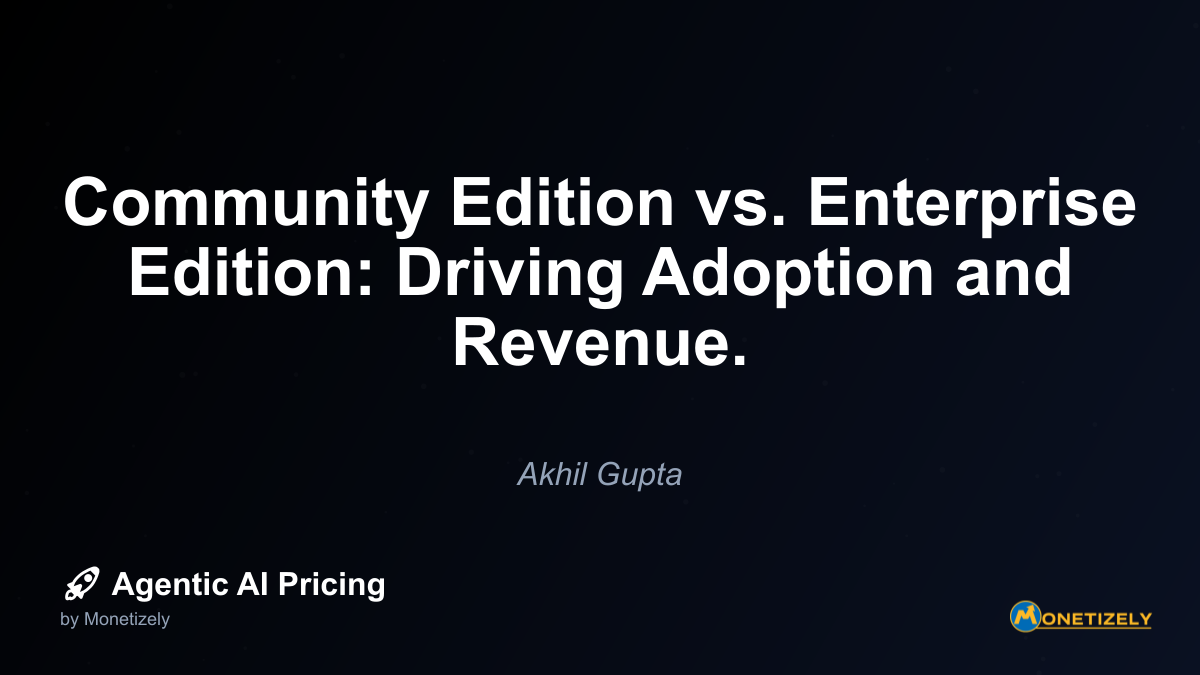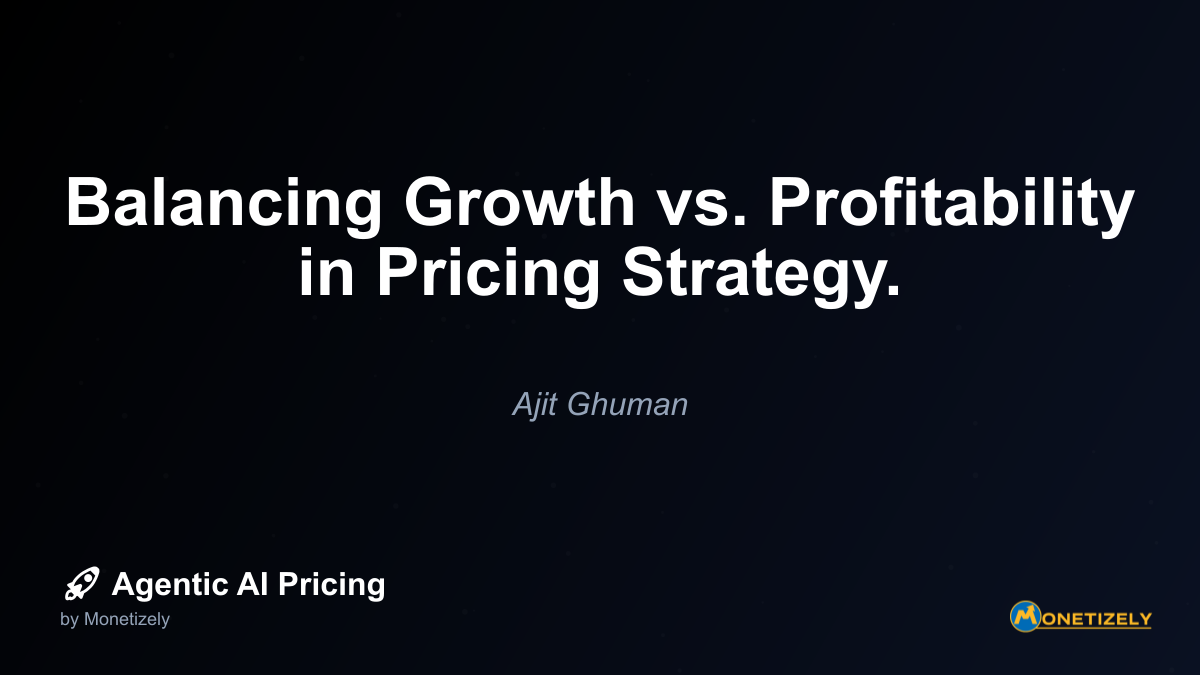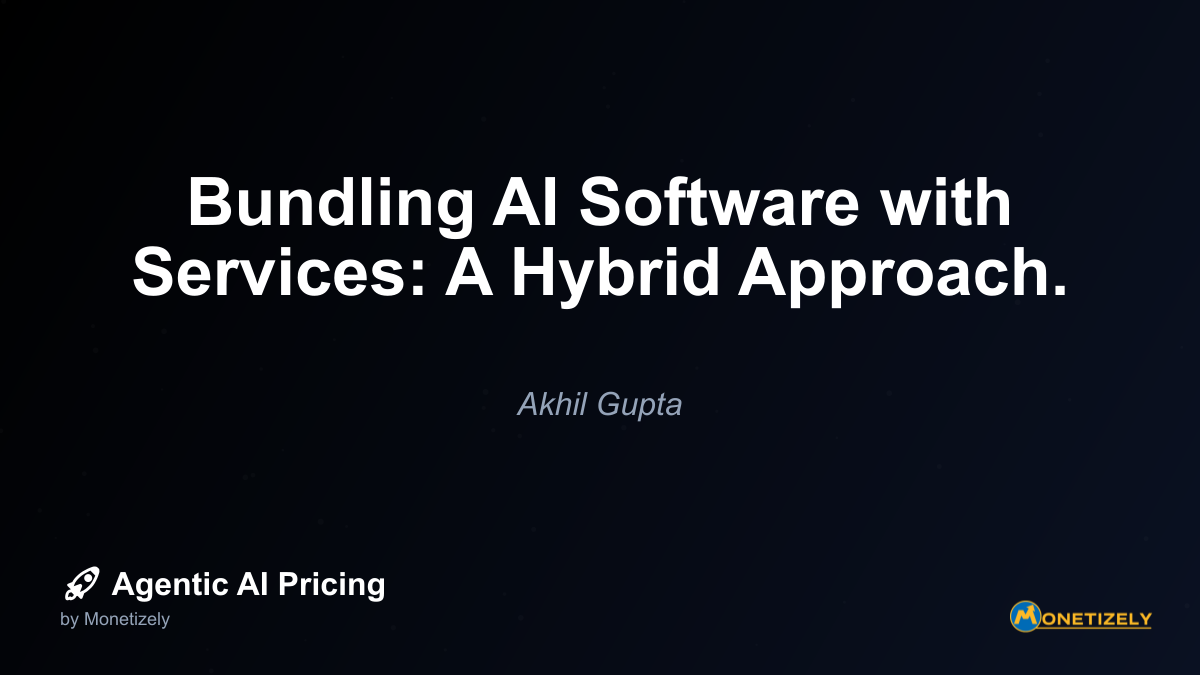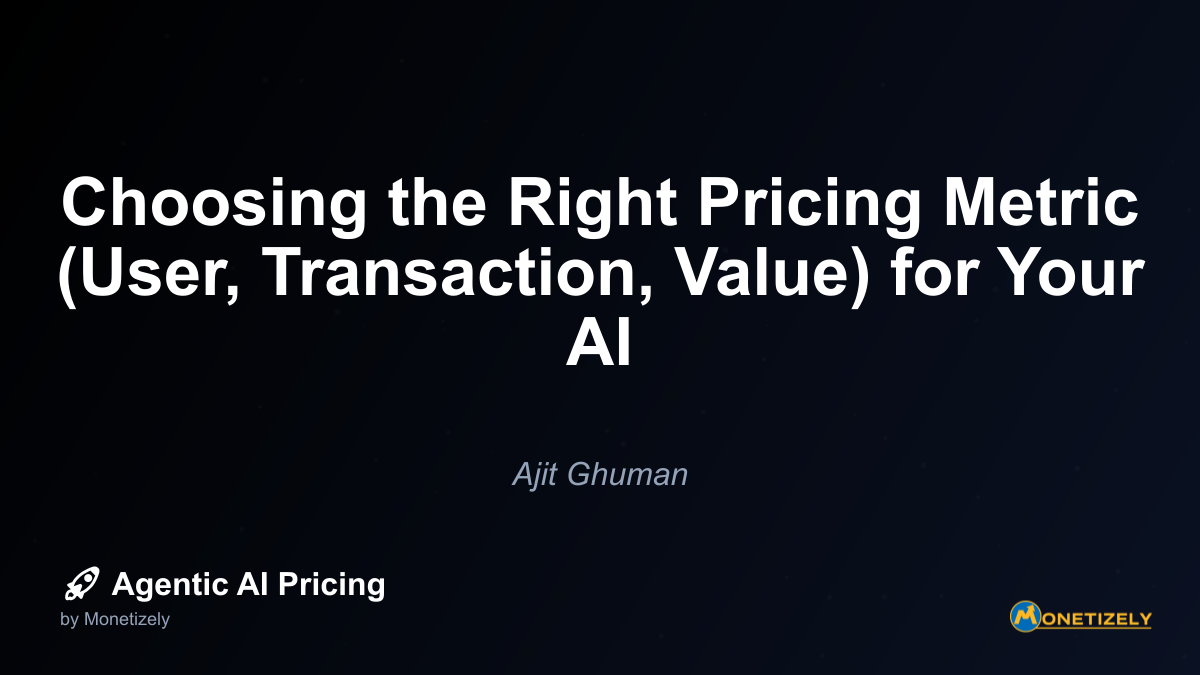· Akhil Gupta · Strategy & Planning · 9 min read
Community Edition vs. Enterprise Edition: Driving Adoption and Revenue.
AI and SaaS Pricing Masterclass
Learn the art of strategic pricing directly from industry experts. Our comprehensive course provides frameworks and methodologies for optimizing your pricing strategy in the evolving AI landscape. Earn a professional certification that can be imported directly to your LinkedIn profile.

Understanding the Community Edition Approach
A community edition typically offers core functionality free of charge or at a minimal cost, often with an open-source license that encourages modification, contribution, and transparency. This approach serves multiple strategic purposes:
- Accelerating user adoption: By removing financial barriers, organizations can rapidly build a broad user base.
- Creating developer ecosystems: Open-source models encourage third-party developers to build extensions, plugins, and integrations.
- Building brand awareness: A free community edition serves as a marketing channel, increasing visibility and credibility.
- Gathering feedback: A large user base provides valuable insights for product improvement.
- Establishing technical credibility: Open-source code allows technical users to validate the quality and security of the solution.
The community edition isn’t merely a stripped-down teaser—it provides genuine value while creating a foundation for enterprise adoption. For AI tools specifically, community editions often include core algorithms, basic interfaces, and fundamental capabilities that demonstrate the tool’s potential.
The Enterprise Edition Value Proposition
While the community edition focuses on accessibility and adoption, the enterprise edition targets organizations with more complex requirements, larger scale, and greater resources. The enterprise value proposition typically centers around:
- Enhanced functionality: Advanced features, integrations, or capabilities not available in the community version.
- Professional support: Dedicated technical assistance, service level agreements, and expert guidance.
- Security and compliance: Additional security features, compliance certifications, and enterprise-grade protections.
- Scale and performance: Optimizations for handling larger workloads, more users, or higher transaction volumes.
- Administration tools: Enterprise-grade management, monitoring, and governance capabilities.
- Integration capabilities: Pre-built connectors to enterprise systems and customization options.
For AI-specific tools, enterprise editions might include more sophisticated models, higher accuracy, greater throughput capacity, or specialized capabilities for particular industry use cases.
The Strategic Interplay Between Community and Enterprise
The most successful implementations of this model recognize that community and enterprise editions aren’t separate products but interconnected components of a unified strategy. Key aspects of this interplay include:
Path to Conversion
The community edition serves as an on-ramp to enterprise adoption. This progression typically follows predictable patterns:
- Individual adoption: Technical practitioners discover and use the community edition.
- Team adoption: Usage spreads within teams as practitioners demonstrate value.
- Departmental adoption: As usage grows, departments begin standardizing on the tool.
- Enterprise consideration: When usage reaches critical mass, organizations evaluate enterprise-wide deployment.
- Enterprise conversion: Organizations upgrade to the enterprise edition to support broader implementation.
Successful vendors map this journey and create deliberate touchpoints that facilitate progression through these stages.
Feature Differentiation Strategy
The most challenging aspect of the community-enterprise model is determining which features belong in which edition. This decision requires balancing competing priorities:
- Community edition must deliver real value: If the community edition is too limited, it won’t gain traction.
- Enterprise edition must justify its cost: The additional features must deliver clear, measurable value to enterprise customers.
- Upgrade path must feel natural: The transition from community to enterprise should feel like a logical progression, not a manipulative bait-and-switch.
For AI tools, common differentiation strategies include:
- Scale limitations: Community editions might limit the number of API calls, data volume, or concurrent users.
- Advanced algorithms: Enterprise editions might include more sophisticated or specialized AI models.
- Integration capabilities: Enterprise editions typically offer more robust integration with enterprise systems.
- Management features: Enterprise editions include administration, governance, and monitoring tools.
- Customization options: Enterprise customers often need to tailor solutions to their specific requirements.
The Role of Open Source
For many AI tools, the community edition is explicitly open-source, which introduces additional strategic considerations:
- License selection: Different open-source licenses (MIT, Apache, GPL, etc.) have significant implications for how the code can be used and commercialized.
- Contribution management: Organizations must develop processes for accepting, reviewing, and incorporating community contributions.
- Governance structure: As communities grow, formal governance structures become necessary to manage decision-making.
- Commercial boundaries: Organizations must clearly delineate which components are open-source and which remain proprietary.
Open source adds complexity but also creates unique advantages. As research on open-source vs. proprietary AI agents suggests, the transparency of open source can build trust and credibility—particularly important for AI systems where “black box” concerns are prevalent.
Case Studies: Successful Community-Enterprise Models in AI
Several organizations have successfully implemented the community-enterprise model for AI tools, providing valuable lessons for others considering this approach.
Hugging Face
Hugging Face has built a thriving ecosystem around its open-source transformers library, which provides access to pre-trained models for natural language processing. Their approach includes:
- Community edition: An open-source library with hundreds of pre-trained models accessible to anyone.
- Enterprise offering: Hugging Face Enterprise, which provides additional security, governance, and deployment capabilities for organizations using AI at scale.
- Ecosystem development: The Hugging Face Hub, which serves as a platform for sharing and collaborating on models.
This approach has allowed Hugging Face to become the dominant platform for NLP model sharing while building a viable enterprise business.
H2O.ai
H2O.ai provides open-source machine learning tools alongside enterprise AI platforms:
- Community edition: H2O Open Source, which includes powerful machine learning algorithms accessible to data scientists.
- Enterprise edition: H2O Enterprise AI, which adds automated machine learning, explainability tools, and deployment capabilities.
- Specialized products: Domain-specific solutions for industries like financial services and healthcare.
H2O.ai has effectively used its open-source community to establish technical credibility while building enterprise-grade solutions that address organizational needs.
Databricks
While not exclusively an AI company, Databricks exemplifies the community-enterprise model:
- Community foundation: Built on the open-source Apache Spark project.
- Enterprise platform: The Databricks Lakehouse Platform, which adds security, governance, and collaboration features.
- AI capabilities: MLflow for machine learning lifecycle management and additional AI tools.
Databricks demonstrates how open-source foundations can support enterprise AI platforms that command significant revenue.
Implementation Challenges and Solutions
Organizations implementing the community-enterprise model face several common challenges, each with potential solutions:
Challenge 1: Maintaining Community Engagement
As commercial interests grow, community members may become concerned about the direction of the project.
Solutions:
- Establish clear governance processes that include community representation
- Maintain transparency about roadmap and decision-making
- Continue investing in community edition improvements alongside enterprise development
- Recognize and reward community contributions consistently
Challenge 2: Feature Differentiation Decisions
Determining which features belong in which edition requires difficult tradeoffs.
Solutions:
- Base decisions on user research and clear understanding of different segment needs
- Focus enterprise features on organizational (not individual) requirements
- Consider time-based differentiation (enterprise gets features earlier)
- Use natural scaling boundaries (number of users, volume of data) as differentiation points
Challenge 3: Support Burden Management
Large community user bases can create unsustainable support demands.
Solutions:
- Build self-service support resources like documentation and knowledge bases
- Foster community-based support through forums and discussion groups
- Develop clear escalation paths for critical issues
- Use community feedback to improve product quality and reduce support needs
Challenge 4: Revenue Timing and Investment Balance
Community growth requires investment before enterprise revenue materializes.
Solutions:
- Establish clear metrics for community health and conversion potential
- Set realistic timelines for enterprise revenue development
- Consider complementary revenue streams during community growth phase
- Maintain disciplined focus on enterprise-relevant features
Challenge 5: Sales and Marketing Alignment
Different approaches are needed for community adoption versus enterprise sales.
Solutions:
- Develop distinct but coordinated community and enterprise marketing strategies
- Create specialized sales roles for community-to-enterprise conversion
- Build analytics that track the full journey from community to enterprise
- Train sales teams to understand and respect community culture
Pricing Strategies for Enterprise Editions
While community editions typically have simple pricing models (free or low-cost), enterprise editions require more sophisticated approaches:
Value-Based Pricing
The most effective enterprise pricing strategies focus on the value delivered rather than costs or competitive benchmarks. For AI tools, value metrics might include:
- Productivity improvements
- Error reduction
- Decision quality enhancement
- Risk mitigation
- Compliance assurance
- Innovation acceleration
By quantifying these benefits, organizations can set prices that capture a fair portion of the value created while remaining attractive to customers.
Tiered Enterprise Approaches
Many organizations implement multiple enterprise tiers to address different segments:
- Professional tier: For smaller teams or departments with moderate needs
- Enterprise tier: For organization-wide deployments with comprehensive requirements
- Custom tier: For large enterprises with unique or complex needs
Each tier typically includes different levels of functionality, support, and scale capabilities.
Consumption-Based Components
For AI tools specifically, many enterprise editions include consumption-based elements:
- API call volumes
- Compute resources utilized
- Data processed
- Model training time
- Prediction volumes
These consumption metrics can be included in fixed tiers (e.g., “up to X API calls per month”) or implemented as variable components alongside base subscription fees.
Transition Incentives
To encourage community-to-enterprise conversion, organizations often implement specific incentives:
- Time-limited promotional pricing
- Migration assistance
- Training credits
- Proof-of-concept support
- Grandfathered pricing for early adopters
These incentives reduce friction in the conversion process while creating urgency for decision-making.
Measuring Success in Community-Enterprise Models
Effective measurement is essential for optimizing community-enterprise strategies. Key metrics typically fall into several categories:
Community Health Metrics
- Active user growth
- Retention and engagement
- Contribution volume and quality
- Community satisfaction
- Developer ecosystem growth
Conversion Funnel Metrics
- Community-to-trial conversion rate
- Trial-to-paid conversion rate
- Conversion cycle time
- Influence factors (which community activities predict conversion)
Enterprise Performance Metrics
- Customer acquisition cost
- Customer lifetime value
- Net revenue retention
- Expansion revenue
- Enterprise customer satisfaction
Ecosystem Metrics
- Integration partner growth
- Marketplace activity
- Third-party extensions
- Educational content development
- Community-led innovation
By tracking these metrics comprehensively, organizations can identify opportunities for optimization and make data-driven decisions about resource allocation.
Future Evolution of the Community-Enterprise Model for AI
As AI technologies continue to evolve, the community-enterprise model is likely to adapt in several ways:
Increased Specialization
As AI markets mature, we’re likely to see more domain-specific community-enterprise models focused on particular industries or use cases. These specialized approaches will feature:
- Industry-specific data models and workflows
- Compliance capabilities for regulated industries
- Pre-built integrations with industry-standard systems
- Domain-specific AI models and capabilities
Embedded AI Components
Rather than standalone AI tools, many future implementations will embed AI capabilities into existing workflows and systems. This approach will require:
- API-first architecture for both community and enterprise editions
- Flexible deployment options (cloud, on-premise, hybrid)
- Strong integration capabilities
- Clear value metrics tied to workflow improvements
Collaborative AI Development
As AI becomes more complex, collaborative development between vendors, customers, and communities will become increasingly important. Future models might include:
- Shared model training across community members
- Federated learning approaches that preserve data privacy
- Collaborative annotation and data labeling
- Joint research initiatives between vendors and customers
Ethical AI Considerations
As ethical concerns about AI grow, community-enterprise models will need to address these issues explicitly:
- Transparency about model limitations and biases
- Clear governance frameworks for responsible AI use
- Auditability and explainability features
- Ethical usage guidelines and enforcement mechanisms
Organizations that proactively address these ethical considerations will gain competitive advantages as regulatory scrutiny increases.
Conclusion: Balancing Community and Commercial Success
The community-enterprise model offers a powerful approach for AI tool providers seeking to combine wide adoption with sustainable revenue. By thoughtfully balancing community engagement and enterprise value creation, organizations can build thriving ecosystems that benefit all stakeholders.
Successful implementation requires careful attention to several key factors:
Genuine value in both editions: Both community and enterprise editions must deliver meaningful benefits to their respective audiences.
Clear, logical differentiation: The distinction between editions should feel natural and reasonable, not arbitrary or manipulative.
Ongoing community investment: Continued investment in the community edition and ecosystem remains essential even as enterprise revenue grows.
Transparent communication: Open, honest communication about roadmap, limitations, and strategic direction builds trust across both communities.
Aligned organizational structure: Internal teams, incentives, and processes must support both community engagement and enterprise revenue goals.
Organizations that master these balancing acts can achieve the best of both worlds: the innovation, adoption, and credibility that come from vibrant communities alongside the revenue, resources, and stability that enterprise customers provide.
For AI tools specifically, this balanced approach addresses one of the field’s fundamental challenges—building trust while creating sustainable business models. By opening core capabilities to community scrutiny while developing enterprise features that address organizational needs, AI providers can overcome adoption barriers while establishing durable commercial foundations.
The community-enterprise model isn’t merely a pricing strategy—it’s a comprehensive approach to technology development and commercialization that recognizes the interconnected nature of adoption and monetization in the AI era.
Co-Founder & COO
Akhil is an Engineering leader with over 16+ years of experience in building, managing and scaling web-scale, high throughput enterprise applications and teams. He has worked with and led technology teams at FabAlley, BuildSupply and Healthians. He is a graduate from Delhi College of Engineering and UC Berkeley certified CTO.
Pricing Strategy Audit
Let our experts analyze your current pricing strategy and identify opportunities for improvement. Our data-driven assessment will help you unlock untapped revenue potential and optimize your AI pricing approach.




